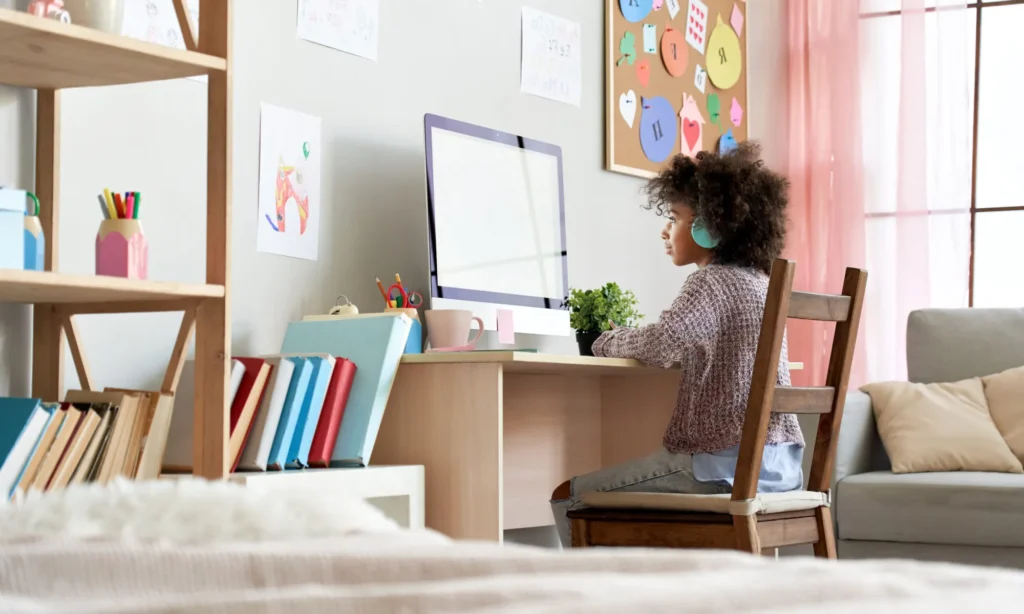Many parents want to learn English with their kid, teaching the kid on their own at home. It is really great when a parent can proudly say that they taught their kid to speak English on their own! And this is not as difficult as before, there is tons of information on the Internet; webinars and intensive courses on social networks like ‘English with your kid at home’ or ‘How to make your kid bilingual’. Moms and dads delve into all this stuff, but eventually they stop having lessons with their kid. What’s wrong? Let us find out. This can also be useful for those parents who want to teach their kids at home on their own, but have difficulties with sorting out where and how to start.
When and how to start learning English with your kid
Many children between 3 and 4 cannot speak their native language properly. But this doesn’t mean that they cannot study another language, or even two or three of them.OIn the contrary, researchers have long agreed that it is easier for a child to learn a second or third language exactly when their brain is acquiring the mechanisms of learning their mother tongue. But there are a number of principles to follow, the most important of which is creating a proper environment that would allow them speak different languages at different times.
Basic principle of teaching English to children
The best option for organising the learning process at home would be when the kid speaks their native language with their dad, and English with their mom, or vice versa. Or the kid speaks English with any relative on a regular basis. For example, with a grandmother, if of course she can help with this.
It is actually difficult to follow this principle in real life for many reasons, that’s why you may want to pick one of the following rules:
- Speak your native language with your kid, for example, in the morning, and speak English in the evening.
- Use your mother tongue at home, and English while out for a walk.
- Play, draw, and sculpt only in English.
In other words, English must become a matter of your routine just like having lunch or dinner or going to bed, with a strict time schedule to use English. Why? Let’s explain. The thing is children at this age (3-5 years old) acquire a foreign language much more like they acquire their mother tongue, i.e. intuitively and naturally. If you start speaking English with your kid at the same time and in the same conditions, then the kid’s brain will develop a reflex, like eating, and it will switch to English automatically. That’s why this principle—using English at strictly defined times—is a basic principle in a foreign language for children.
The main psychological problems that influence children learning English and their consequences.
Every parent of course knows the individual traits of their child. Below, we mention those traits that are general for the children of the given age group, and those traits that have a direct impact on learning English. Keep in mind that:
- Children are active. They need physical activity. Movement helps memorisation.
- Children are quick to learn and to forget. You will need to constantly repeat what you have taught them.
- Children use all their emotions and not just to speak. They need to have a visual image, hear a sound, touch, smell and taste. Let them learn English through all their senses.
- Children have rich imaginations. Use them.
- Children love having fun. Enjoy the learning process, be enthusiastic about it, and everything will be great!
- Children are just children. Don’t have high expectations. Everything comes at the right time.
Basic things to know when you teach small children to speak English.
Children learn through communication; so speech is the key. But not the kids’ speech. Start with yours. Here are some important things to know:
- Speak at a normal speed (unless you naturally speak extremely fast). It will take time until the kid starts hearing separate words, but soon they will be able to understand spoken English at a normal speed.
- Do not fragment your sentences with the idea that you are helping the kid to identify separate words; just use normal pronunciation and intonation. Remember that kids at this stage learn by imitation.
- Use English everywhere you can. Instructions and questions are very important because they help build communication skills.
- Use full sentences and phrases. And demand the same from the kid. For example, answering the question “What is it?” The kid needs to say “It’s a ball”, and not just “Ball”. If you learn colours, teach them to say “a yellow banana” or “a red apple”. Some kids may answer “yellow banana” to the question “What colour is a banana?” But the kid will correct themselves quickly because they have learnt subconsciously to put an article and adjective before a noun.
Sometimes it may seem that it would be better if the kid learnt to pronounce separate words first, and only then sentences. This is a common misconception. Children memorise cliche-like sentences better, rather than making correct sentences from words. Just think of the way the kid listens to the whole sentence in their mother tongue and they imitate the adults by pronouncing sentences and not words! Moreover, using whole sentences, children:
- Gain an understanding of the context.
- Learn the syntax and different structures they can use later while building their own sentences.
- Find it easier to use ready sentences or phrases rather than separate words.

Using your mother tongue—a ‘sandwich’
Not all kids gladly agree to speak English with their parents and, if you switch to this with no preparation, they may start protesting. Especially when kids are not 3 or 4. If this is the case with your kid, try a smoother transition to using English, adding English sentences (not words, see above) to your conversation in your mother tongue. Try to follow the rule given below and stay focused on your goal of teaching English to your kid. The child will accept it slowly and will develop a positive attitude towards speaking English. Well:
- Start speaking English by giving short instructions and use the ‘sandwich’ method: first, pronounce a word in English, then in your mother tongue, then again in English (Sleep! ?????! Sleep!)
- At the very beginning, you will have to use your mother tongue, especially trying to explain things in English. But, from the very beginning, stick to the sentences you are going to use in future. As a rule, these are the most frequent phrases. The child will learn to understand them quickly, while you will succeed in creating an English language learning environment from the get-go.
- Use your mother tongue less and less from lesson to lesson.
- Once you notice that the kid uses certain expressions in a more or less correct way, make sure they use them constantly. Do not allow them to use their mother tongue. The kid may continue to use their mother tongue even after multiple reminders. If they forget to use English, then:
- Cheer them up (for example, by saying something like “You know this already, let’s use it!”). In some urgent situations (when you ask something, for example), you can remind them, but do not make it a habit to let them wait for your help.
Children do not understand how much they know. They often think they know little because this is how their parents think. But this is, again, a misunderstanding.
Actions and imitations: using body language
Using just your voice will not be enough. Especially at the very beginning, and if your kid is too young. Kids use their bodies spontaneously and do not see their bodies as something separate from the surrounding environment. Use this through actions and imitations. They will help:
- Understanding spoken things better.
- Attract the kid’s attention.
- Consolidate words and structures.
- Correct the kid’s mistakes or remind them.
You’ll notice that the kid uses your movements while speaking, until they are confident in speaking properly, then the kid will stop imitating movements unconsciously.
How to attract the kid’s attention
The kid will not listen to you, see you, or understand you until you get their full attention. This is a fact. Think of the traits of children in primary school we talked about earlier. And now let’s understand how to use them to attract kids’ attention:
- Children can stay focused for a very short period of time. Make your activities short and change them more often.
- Children are active and they need to move. Change the rhythm of your activities by alternating physical activity with more calm and less active exercises.
- Repeat from time to time the material you covered earlier, by using as many ways as possible (but if the kid loves a particular way, you can stick to it).
- Maintain good eye contact with the kid.
- Change your speaking style (speak louder, whisper, use a higher pitch, etc.).
- Use tons of various movements and imitations. Simplify your mimics.
- Teach the kid to participate actively, interrupting yourself and asking, for example: “‘… and the wolf has eaten the cake…’ show me how he ate the cake. Are you ready?” (the kid imitates eating a cake). “And what do you think he is going to do now?”
- Kids love touching things, so let them touch objects, have them in their hands, throw and find. Use real objects to touch them. Or taste them if, for example, it’s about food.
- Use puppets not only to attract attention but also to teach the kids to speak. Younger children often avoid talking to adults, but they would be happy to talk to their dolls. Or, they are too shy to start the conversation and, if they have a doll with them, they will talk as if the doll speaks.
- Do not get worried or stressed out. Relax and enjoy the lesson. If the kid feels that their parent is feeling good, the child will be more active and attentive.
When you should expect results
It is strange but people consider it normal that kids can be silent before learning to speak their native language; at the same time, while learning English, they expect kids to start speaking from the very beginning. Children, in fact, have different learning speeds. Some start using English from the get-go. Usually it’s girls, musically gifted kids or just more talkative ones who learn a new language faster and easier. Other kids may need a month or two, yet others may need half a year or even a year to start speaking. There may be a huge difference among kids of the same age. Be patient. Do not compare your kid to the neighbour’s. Your kid will speak English!
Some useful life hacks: how to believe that you can teach your kid to speak English at home
- Try to record what you usually talk about in your mother tongue. Make a list of the most frequent phrases you use. Can you teach the English versions of these phrases and sentences so that you could avoid using your mother tongue in everyday life? Check in the dictionary or ask someone. Try to change some instructions known to your kid for their versions in English.
- Do not worry if your English is not perfect or good enough. According to statistics, most teachers in primary school worldwide are not fluent in English. Nevertheless, they teach kids very well. At this stage the most important thing is to make kids love the language. This is your primary goal. Keep in mind that kids even make mistakes when speaking their mother tongue. They have many years to improve their language skills.
- If you allow your kid to acquire the language in a friendly environment by doing things they enjoy, most probably the child will not be afraid of speaking English and be more successful in learning language later as a conscious process.
If you want to know about the best way to organise English lessons with kids and how to apply all the principles we talked about, we would recommend you register for a trial lesson in the Novakid online English school. English video lessons for children from 4 to 12 have been created based on these principles; our tutors are professionals who will help your kid overcome different difficulties in mastering English. You should try it!








































